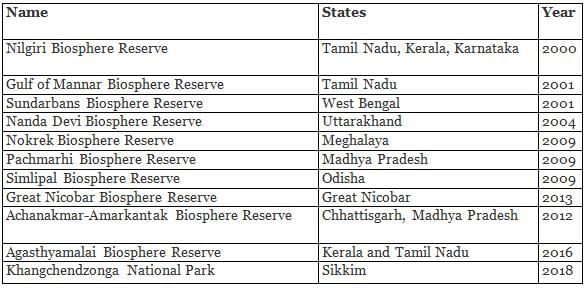Test: Environment- 6 - UPSC MCQ
25 Questions MCQ Test - Test: Environment- 6
Consider the following statements about Bioaerosols
- Bioaerosols can be formed from fungi and bacteria only.
- Plants, soil, water, animals and humans all serve as sources of bioaerosols.
- With higher humidity, higher bioaerosol levels can prevail.
Which of the above statements is/are correct?
Which of the following are part of UNESCO’s World Network of Biosphere Reserves
- Nilgiri Biosphere Reserve
- Manas Biosphere Reserve
- Nokrek Biosphere Reserve
- Kachchh Biosphere Reserve
- Great Nicobar Biosphere Reserve
Select the correct code:
Consider the following statements about the effects of species diversity on community
- Higher productivity
- High yearly variation in total biomass
- Increase in resistance to invasive alien species
Which of the above statements is/are incorrect?
Which of the following adds/add nitrogen to the soil?
- Burning of coal by man
- Death of vegetation
- Excretion of urea by animals
Select the correct answer using the codes given below.
Consider the following statements about Bioplastics
- Bioplastics can be made from used plastic bottles containing microorganisms
- All bioplastics are biodegradable
- Bioplastics can increase stratospheric ozone depletion compared to conventional plastics
Which of the above statements is/are correct?
Birds Following Army Ants is an example for which of the following types of symbiotic relationship between organisms?
Which of the following statements is/are correct with respect to Agenda 21?
- It is a comprehensive plan of action to be taken globally, nationally and locally.
- It is a non-binding action plan.
Select the correct answer using the codes given below:
Mangroves, saltwater crocodile, Indian python, wild pigs and rhesus monkeys are found in which of the following national park?
Consider the following statements.
- Bioleaching is used essentially for the recovery of copper, uranium and gold.
- Biosparging can be used to reduce concentrations of petroleum constituents that are dissolved in groundwater.
- Bioaugmentation can be involved in bioremediation.
Which of the above statements is/are correct?
Consider the following statements about TRAFFIC, the wildlife trade monitoring network.
- It is a joint program of WWF and UNEP.
- TRAFFIC is a leading non-governmental organisation working globally on trade in wild animals and plants in the context of both biodiversity conservation and sustainable development.
- To achieve this goal, it works with national and international conventions, governments, enforcement agencies, private sector companies and consumers.
Select the correct code:
Recently the Government Launched ‘Asiatic Lion Conservation Project’.
Consider the following statements.
- It is 100 percent Central funded scheme.
- The project activities include scientific interventions, disease control and veterinary care.
- Asiatic Lions are listed as ‘Endangered’ under the IUCN Red List.
- Asiatic Lion population is restricted to the state of Gujarat in India.
Select the correct code:
Consider the following statements about Agenda 21
- Agenda 21is a non-binding action plan of the United Nations with regard to sustainable development.
- It is a product of the Earth Summit (UN Conference on Environment and Development) held in Rio de Janeiro, Brazil, in 1992.
- The “21” in Agenda 21 refers to 21 points agreed upon by the member countries to achieve sustainable development.
Select the correct code:
Which of the following are the effects of ozone layer depletion
- Causes non-melanoma skin cancer
- Affects the physiological and developmental processes of plants
- Phytoplankton productivity is limited to the euphotic zone
- Synthetic polymers are adversely affected
Select the correct code:
Consider the following statements about the application of algae.
- Used to make Biodiesel and Bioethanol.
- It is a complete protein with essential amino acids.
- Used as fertilizers and soil conditioners.
- Used in Wastewater Treatment.
Which of the above statements is/are correct?
Which of the following are an ecotone?
- Mangroves
- Grassland
- Forest
- Estuary
- Coral Reef
Select the correct code:
Which of the following fall under the category of Primary pollutants?
- Oxides of Sulphur
- Particulate Matter
- POPs (Persistent Organic Pollutants)
- Chlorofluorocarbons
- Ground Level Ozone
Select the correct code.
Consider the following pairs:

Which of the above pairs are correctly matched
Consider the following statements about ‘Pioneer species’.
- They are the first to colonize previously disrupted or damaged ecosystems.
- They are often photosynthetic plants
- Algae, Mosses and Lichens are the examples of pioneer species.
Which of the above statements is/are correct?
Which of the following adaptations is/are found in the mangrove plants?
- Absence of stomata.
- Turn their leaves to reduce exposure to the sunlight.
- Pneumatophores
- Salt glands
Select the correct code:
Which of the following are responsible for land degradation?
- Overgrazing
- Salination
- Water-logging
- Landslides
- Practice of Jhum cultivation
Select the correct code:
Consider the following pairs.

Which of the above pairs is/are correctly matched?
Which of the following pyramids can be both upright and inverted?
- Pyramid of Biomass
- Pyramid of Numbers
- Pyramid of Productivity
Select the correct code:
The increasing amount of carbon dioxide in the air is slowly raising the temperature of the atmosphere, because it absorbs

















